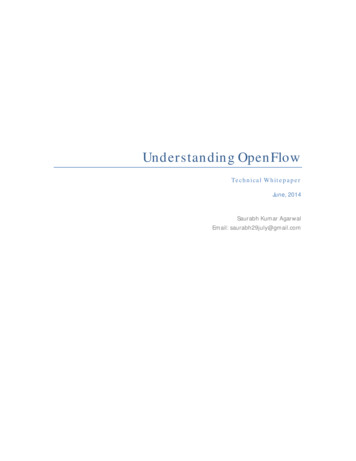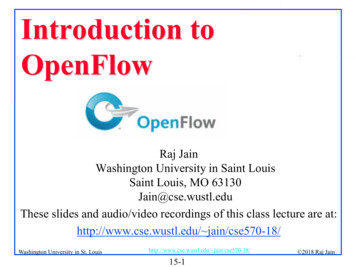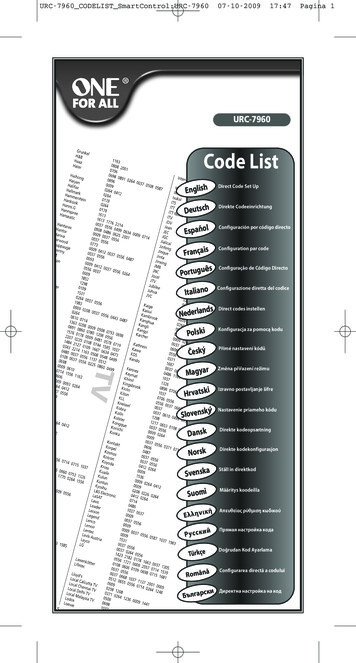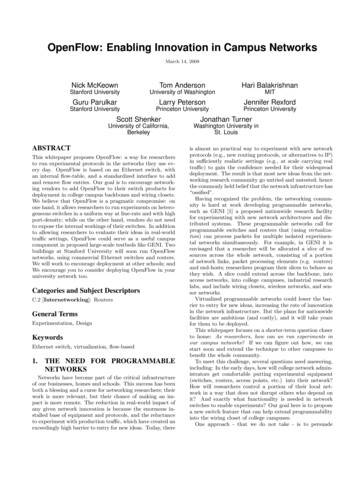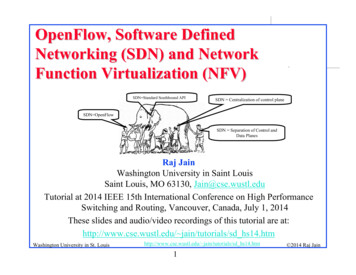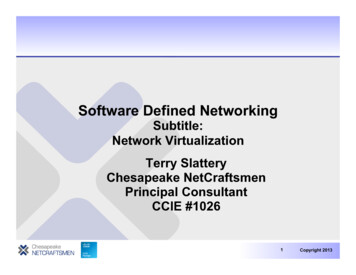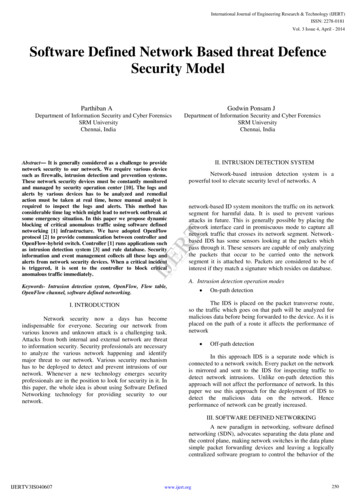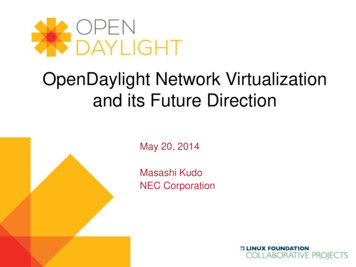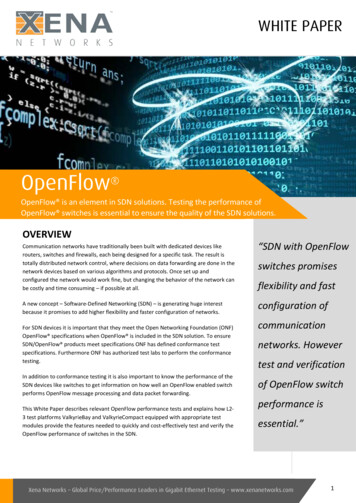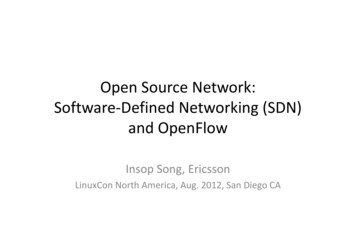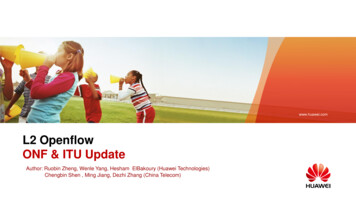
Transcription
www.huawei.comL2 OpenflowONF & ITU UpdateAuthor: Ruobin Zheng, Wenle Yang, Hesham ElBakoury (Huawei Technologies)Chengbin Shen , Ming Jiang, Dezhi Zhang (China Telecom)
Agenda ONF Support for L2 Openflow ITU-T SG15/Q2 Support for L2 openflow Using IEEE 1904.2 ChannelHUAWEI TECHNOLOGIES CO., LTD.Page 2
ONF L2 Openflow Support (1) Openflow 1.3.5, which has been published in March 2015, decouples Openflow protocolfrom the underlying reliable transport. The full OpenFlow protocol can be used over an alternate transport protocol instead of TLS or TCP. The main connection or a reliable auxiliary connection can be defined on an alternate transportprotocol Transport protocol should provide the following functionalities : Multiplexing multiple openflow connections between the openflow switch and multiple or the sameopenflow controller. Reliability. Ordered Delivery. Segmentation and Assembly of openflow frames when the frame size exceed the link MTU. Flow Control SecurityHUAWEI TECHNOLOGIES CO., LTD.Page 3
ONF L2 Openflow Support (2) An unreliable auxiliary connection can be defined on an alternatetransport protocol only if this transport protocol provides multiplexing If the transport protocol can not meet these requirements, an adaptationlayer must be used. Beyond those requirements, the mapping of OpenFlow messages to thealternate transport protocol is defined by the adaptation layer or thetransport protocol and outside the scope of the openflow 1.3.5specification.HUAWEI TECHNOLOGIES CO., LTD.Page 4
Using LLC Type 2 for Reliable L2 CommunicationsOpenflowShim Adaptation Sub-LayerIEEE 802.2Logical Link Control (LLC)IEEE 802.3IEEE 802.4CarrierSenseHUAWEI TECHNOLOGIES CO., LTD.TokenBusOSI Layer 2(Data Link)IEEE 802.5IEEE 802.11TokenRingWirelessMacPHYPage 5OSI Layer 1(Physical)
Using OMCI to Carry Openflow Messages in GPON Huawei proposed in ITU-T SG15/Q2 using OMCI as a transport protocol forOpenflow instead of extending it to provide another OpenFlow-like protocol. OMCI does not need to change to keep pace with frequent changes of OpenFlow. Huawei proposed to add a new ME, i.e. OpenFlow config data management Entity, into currentG.988 in order to support seamlessly transportation of OpenFlow packets in a PON system. It is worth noting that similar Approach can be used with IEEE 802.3 OAM. Huawei proposal has been accepted. The new OMCI spec (G.988 Amd2) with L2 Openflow support will be approved inFebruary, 2016, and then will be published after that.HUAWEI TECHNOLOGIES CO., LTD.Page 6
Using IEEE 1904.2 ChannelThe advantages of using IEEE 1904.2Channel are:1.2.3.Allow L2-only devices to identify andexclude the management and controltraffic from subscriber’s SLA quotas.Move management and control traffic inthe access network out of the “userchannel” – avoid impact to user trafficstatisticsAllow L2 management/control messagesthat have link scope (e.g. IEEE eOAM) toreach devices that are multiple hubsaway from the management master orthe controllerHUAWEI TECHNOLOGIES CO., LTD.Page 7
Thank YouHUAWEI TECHNOLOGIES CO., LTD.Page 8
Data Link Layer -- LLC Logical Link Control (LLC) For IEEE 802, flow control, error control, and part of the framing duties are all broughttogether in this LLC sub-layer. Framing is also performed in the MAC sub-layer. The LLC provides a single data link control protocol for all IEEE LANs. (Contrast thiswith the MAC layer where we have different protocol versions for different LANs. Seeprevious slide.) The LLC makes the MAC sub-layer transparent. Framing LLC provides a PDU similar to HDLCHUAWEI TECHNOLOGIES CO., LTD.Page 9
LLC Sublayer Connectionless Mode of Operation The LLC sublayer standard, ISO/IEC 8802-2, describes two types of connection-less mode of operationfor data communication between service access points: Unacknowledged connectionless-mode (type 1), Information frames are exchanged between LLC entities without the need for the prior establishment of alogical link between peers. The LLC sublayer does not provide any acknowledgments for these LLCframes, nor does it provide any flow control or error recovery procedures. LLC type 1 also provides a TEST function and an Exchange Identification (XID) function. The capabilityto act as responder for each of these functions is mandatory: This allows a station to check thefunctioning of the communication path between itself and any other station, to discover the existence ofother stations, and to find out the LLC capabilities of other stations. Acknowledged connectionless-mode (type 3). With type 3 operation, information frames are exchanged between LLC entities without the need for theprior establishment of a logical link between peers. However, the frames are acknowledged to allow errorrecovery and proper ordering. Further, type 3 operation allows one station to poll another for data This type has little or no commercial use.HUAWEI TECHNOLOGIES CO., LTD.Page 10
LLC Sublayer Connection-mode of Operation Connection-mode (type 2): A logical link is established between pairs of LLC entities prior to any exchange ofinformation frames. In the data transfer phase of operation, information frames are transmitted and deliveredin sequence. Error recovery using positive ACK and retransmission. F low control using fixed-length sliding window of 8 frames are provided within the LLCsublayer. Systems on the same IEEE 802.2 network may use 802.2 Type 2communications after verifying that it is supported by both ends. This isaccomplished using the 802.2 XID mechanismHUAWEI TECHNOLOGIES CO., LTD.Page 11
User Data Encapsulation Type Field Encoding The length/type field (2 bytes) in the Ethernet frame contains a type value in the range of 0x600 to0xFFFF indicating the higher-layer protocol that is being encapsulated. The most common encapsulation used on Ethernet. Ethertype values are registered with IEEE: e/ Type field assignments are administered by the Registration Authority, IEEE StandardsDepartment, P.O. Box 1331, 445 Hoes Lane, Piscataway, NJ 08855-1331, USA. LLC Encoding The SSAP and DSAP identify the higher layer protocol. The control field carries a value indicating the type of frame. LLC type1 uses unnumbered Information and provides connectionless, best effort service. LLC type 2 provides reliable, connection-oriented services.SSAP/DSAP are allocated by IEEE-RA for a protocol which is a standard published by aninternationally recognized standards organization, and has a potentially large field of application.HUAWEI TECHNOLOGIES CO., LTD.Page 12
User Data Encapsulation (2) Clients using Length Encapsulation and LLC can communicate amongthemselves, and Clients using Type Encapsulation can communicate amongthemselves on the same LAN. When Type Encapsulation is used LLC Protocol is not used and does not need tobe present. If a device supports some clients that use Type Encapsulation and others that useLength Encapsulation, the MAC can demultiplex frames to both sets of clientssimultaneously.HUAWEI TECHNOLOGIES CO., LTD.Page 13
IEEE 802 Reference Model for End StationHUAWEI TECHNOLOGIES CO., LTD.Page 14
IEEE 802.1D Bridge Architecture IEEE 802.1D Bridge shall Conform to IEEE Std 802.2 for the implementation of a class of LLCsupporting Type 1 operation as required by 7.3 and 7.1.2. Each Bridge Port shall support the operationof LLC Type 1 procedures in order to support the operation of the Spanning Tree Protocol Entity. BridgePorts may support other types of LLC procedures, which may be used by other protocols. A bridge processes protocols in the MAC sublayer and is functionally transparent to LLC and higherlayer protocols. MAC frames are forwarded between access domains, or filtered (i.e., not forwarded tocertain access domains), on the basis primarily of MAC addressing informationHUAWEI TECHNOLOGIES CO., LTD.Page 15
IEEE 802.1Q Bridge ArchitectureHUAWEI TECHNOLOGIES CO., LTD.Page 16
LLC Framing The LLC header contains a control field like HDLC and is used for flow and errorcontrol. The two access point fields (DSAP and SSAP) define the upper layer protocol atthe source and destination that uses LLC.MAC Header: DA, SA, Tags, Type/LengthHUAWEI TECHNOLOGIES CO., LTD.Page 17
LLC Address FieldsHUAWEI TECHNOLOGIES CO., LTD.Page 18
HUAWEI TECHNOLOGIES CO., LTD. Page 3 ONF L2 Openflow Support (1) Openflow 1.3.5, which has been published in March 2015, decouples Openflow protocol from the underlying reliable transport. The full OpenFlow protocol can be used over an alternate transport protocol instead of TLS or TCP. The main connection or a reliable auxiliary connection can be defined on an alternate transport
